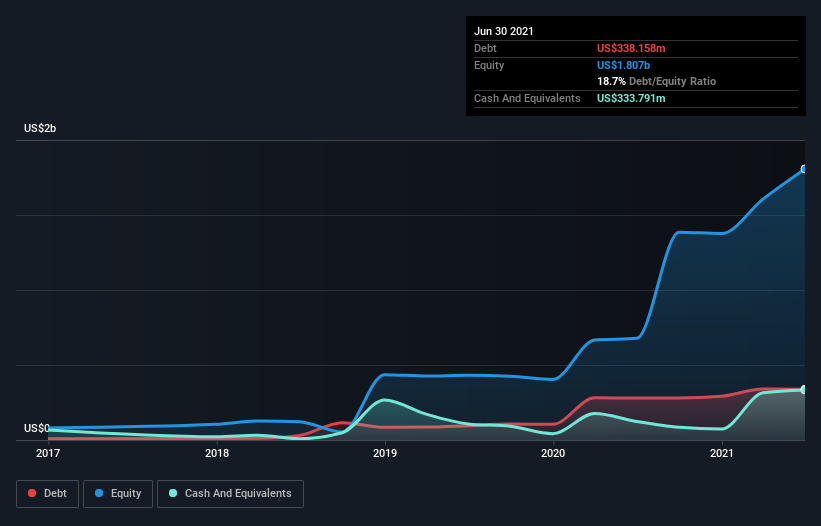
The external fund manager backed by Berkshire Hathaway's Charlie Munger, Li Lu, makes no bones about it when he says 'The biggest investment risk is not the volatility of prices, but whether you will suffer a permanent loss of capital.' It's only natural to consider a company's balance sheet when you examine how risky it is, since debt is often involved when a business collapses. As with many other companies Curaleaf Holdings, Inc. (CSE:CURA) makes use of debt. But is this debt a concern to shareholders?
When Is Debt A Problem?
Debt assists a business until the business has trouble paying it off, either with new capital or with free cash flow. Part and parcel of capitalism is the process of 'creative destruction' where failed businesses are mercilessly liquidated by their bankers. However, a more common (but still painful) scenario is that it has to raise new equity capital at a low price, thus permanently diluting shareholders. Of course, the upside of debt is that it often represents cheap capital, especially when it replaces dilution in a company with the ability to reinvest at high rates of return. The first thing to do when considering how much debt a business uses is to look at its cash and debt together.
See our latest analysis for Curaleaf Holdings
What Is Curaleaf Holdings's Net Debt?
As you can see below, at the end of June 2021, Curaleaf Holdings had US$338.2m of debt, up from US$279.8m a year ago. Click the image for more detail. However, it does have US$333.8m in cash offsetting this, leading to net debt of about US$4.37m.

How Healthy Is Curaleaf Holdings' Balance Sheet?
Zooming in on the latest balance sheet data, we can see that Curaleaf Holdings had liabilities of US$215.3m due within 12 months and liabilities of US$1.13b due beyond that. Offsetting this, it had US$333.8m in cash and US$49.7m in receivables that were due within 12 months. So it has liabilities totalling US$964.2m more than its cash and near-term receivables, combined.
Of course, Curaleaf Holdings has a market capitalization of US$7.27b, so these liabilities are probably manageable. However, we do think it is worth keeping an eye on its balance sheet strength, as it may change over time. But either way, Curaleaf Holdings has virtually no net debt, so it's fair to say it does not have a heavy debt load!
In order to size up a company's debt relative to its earnings, we calculate its net debt divided by its earnings before interest, tax, depreciation, and amortization (EBITDA) and its earnings before interest and tax (EBIT) divided by its interest expense (its interest cover). The advantage of this approach is that we take into account both the absolute quantum of debt (with net debt to EBITDA) and the actual interest expenses associated with that debt (with its interest cover ratio).
Curaleaf Holdings's debt of just 0.018 times EBITDA is clearly modest. But strangely, EBIT was only 1.9 times interest expenses, suggesting the that may paint an overly pretty picture of the stock. Notably, Curaleaf Holdings's EBIT launched higher than Elon Musk, gaining a whopping 330% on last year. When analysing debt levels, the balance sheet is the obvious place to start. But it is future earnings, more than anything, that will determine Curaleaf Holdings's ability to maintain a healthy balance sheet going forward. So if you're focused on the future you can check out this free report showing analyst profit forecasts.
Finally, a business needs free cash flow to pay off debt; accounting profits just don't cut it. So we always check how much of that EBIT is translated into free cash flow. During the last two years, Curaleaf Holdings burned a lot of cash. While investors are no doubt expecting a reversal of that situation in due course, it clearly does mean its use of debt is more risky.
Our View
We weren't impressed with Curaleaf Holdings's interest cover, and its conversion of EBIT to free cash flow made us cautious. But its EBIT growth rate was significantly redeeming. Looking at all this data makes us feel a little cautious about Curaleaf Holdings's debt levels. While debt does have its upside in higher potential returns, we think shareholders should definitely consider how debt levels might make the stock more risky. The balance sheet is clearly the area to focus on when you are analysing debt. However, not all investment risk resides within the balance sheet - far from it. To that end, you should be aware of the 3 warning signs we've spotted with Curaleaf Holdings .
Of course, if you're the type of investor who prefers buying stocks without the burden of debt, then don't hesitate to discover our exclusive list of net cash growth stocks, today.
New: AI Stock Screener & Alerts
Our new AI Stock Screener scans the market every day to uncover opportunities.
• Dividend Powerhouses (3%+ Yield)
• Undervalued Small Caps with Insider Buying
• High growth Tech and AI Companies
Or build your own from over 50 metrics.
This article by Simply Wall St is general in nature. We provide commentary based on historical data and analyst forecasts only using an unbiased methodology and our articles are not intended to be financial advice. It does not constitute a recommendation to buy or sell any stock, and does not take account of your objectives, or your financial situation. We aim to bring you long-term focused analysis driven by fundamental data. Note that our analysis may not factor in the latest price-sensitive company announcements or qualitative material. Simply Wall St has no position in any stocks mentioned.
Have feedback on this article? Concerned about the content? Get in touch with us directly. Alternatively, email editorial-team (at) simplywallst.com.
About TSX:CURA
Undervalued with mediocre balance sheet.
Similar Companies
Market Insights
Community Narratives



